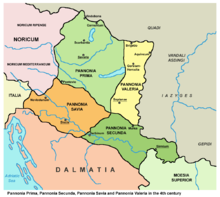Pannonia Prima
| Provincia Pannonia Prima | |||||||||
|---|---|---|---|---|---|---|---|---|---|
| province of the Roman Empire | |||||||||
| 296–5th century | |||||||||
 | |||||||||
| Capital | Savaria | ||||||||
| History | |||||||||
• Established | 296 | ||||||||
• Disestablished | 5th century | ||||||||
| |||||||||
| Today part of | Hungary, Austria, Croatia, Slovenia, Slovakia | ||||||||
Pannonia Prima was an ancient
.Geography
Pannonia Prima included parts of present-day
Pannonia Prima was the northwestern quadrant of the four subdivisions of Pannonia. It was bordered on the west by the
Decline and Fall
Emperor Gratian (367-383) began settling Huns as foederati in Pannonia.[8] Roman money had ceased circulating in all Pannonia north of the Drave (including Pannonia Prima) by 375, indicating that little Roman influence remained in the area. The foederati and Visigothic and Hunnic barbarians caused trouble, and the situation in Pannonia was described by Claudian as "a continual siege" in 399. Pannonia Prima held out under Generidus, but was eventually assimilated into the Huns' territory by 427. Rome would never regain effective control of this area, but nominally remained a Roman province, until the fall of the Ostrogothic Kingdom in 553.[9]
See also
References
- ^ Mocsy, A: "Pannonia and Upper Moesia", pp. 272-3. Boston: Routledge and Kegan Paul Ltd., 1974
- ^ Poczy, K: "Pannonian Cities", in "The Archaeology of Roman Pannonia", eds. Radan, G.T.B. and A. Lengyel, p. 243. Budapest: Akadémiai Kiadó, 1980.
- ^ Mocsy, A: "Pannonia and Upper Moesia", fig. 59. Boston: Routledge and Kegan Paul Ltd., 1974
- ^ Barkoczi, L: "History of Pannonia", in "The Archaeology of Roman Pannonia", eds. Radan, G.T.B. and A. Lengyel, p. 109. Budapest: Akadémiai Kiadó, 1980.
- ^ Strabo's Geography, Section VII, Chapter 5, Section 3
- ^ Mocsy, A: "Pannonia and Upper Moesia", fig. 59. Boston: Routledge and Kegan Paul Ltd., 1974
- ^ Mocsy, A: "Pannonia and Upper Moesia", pp. 302-307. Boston: Routledge and Kegan Paul Ltd., 1974
- ^ Salamon, A, and A. Cs. Sos: "Pannonia - Fifth to Ninth Centuries", in "The Archaeology of Roman Pannonia", eds. Radan, G.T.B. and A. Lengyel, p. 397. Budapest: Akademiai Kiado, 1980.
- ^ Mocsy, A: "Pannonia and Upper Moesia", pp. 342-349. Boston: Routledge and Kegan Paul Ltd., 1974
Literature
- Mócsy, András (2014) [1974]. Pannonia and Upper Moesia: A History of the Middle Danube Provinces of the Roman Empire. New York: Routledge.
- Várady, László (1969). Das Letzte Jahrhundert Pannoniens (376–476). Amsterdam: Verlag Adolf M. Hakkert.
- Wozniak, Frank E. (1981). "East Rome, Ravenna and Western Illyricum: 454-536 A.D." Historia: Zeitschrift für Alte Geschichte. 30 (3): 351–382.
